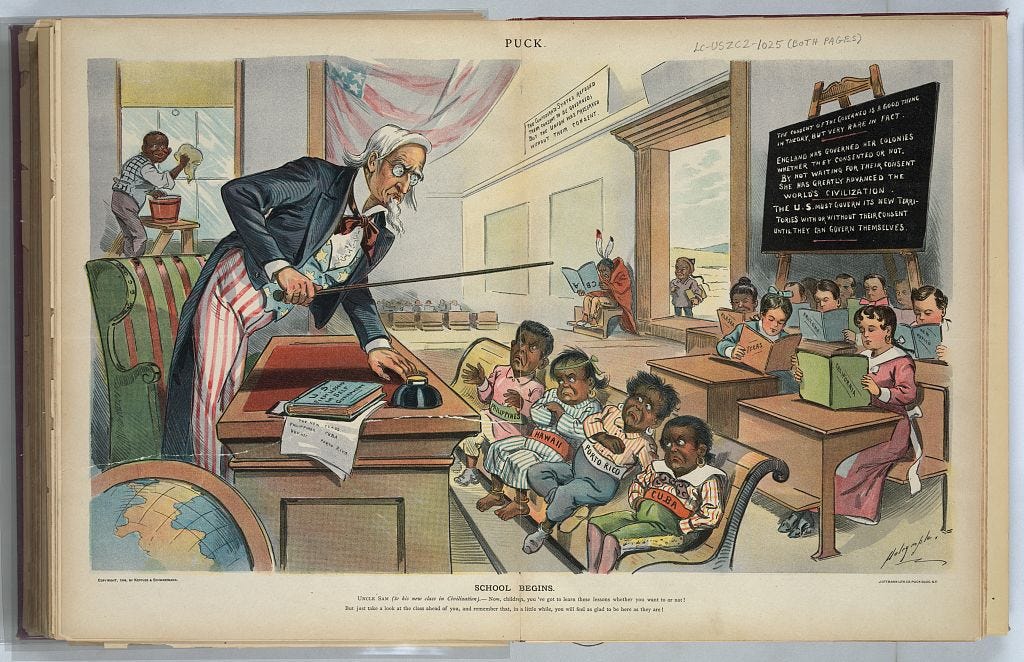Words Matter: How the Right Wing Promotes Fascism Through School Curriculum
A new fascist curriculum hopes to teach (white) students "why their country deserves to be loved, and to learn what we owe to our ancestors—the heroes of the American past."
In recent years, right wing groups have organized vocal, active, even militant movements that have been working to overhaul K-12 public school curriculum to reflect their interests and ideologies. In many states, Republicans have successfully passed laws to limit teaching about race and racism, making many teachers fear that they will be reported for simply using the word white to describe those racialized as white, or for speaking truthfully about the harms of slavery. Currently in Ohio there are concerns about what has been dubbed the “Both Sides Bill” because it would require educators to present two sides to the Holocaust and slavery, among other topics deemed “controversial” or “divisive.” Bills to ban teaching about gender identity and sexual orientation are also being created and passed in many states. So what does all of this have to do with fascism?
This essay is not meant to be an in depth study of fascism nor even of the ways it has long been present in the US. The goal here is to show how individuals and organizations are using fascist language and strategies in their efforts to undermine public education in the U.S.
Right now, a web of far-right groups are attempting to overhaul K-12 public school curriculum. They present themselves as simply concerned parents and educators who are looking out for children and want the best education for them. However, a close reading of their curriculum proposals shows something very different. For example, one coalition is currently promoting a social studies curriculum entitled “American Birthright.” The name alone should give us pause, as it immediately signals not only the intended audience, but also who is and isn’t included in this curriculum. But as we continue to read we will quickly find echoes of Mussolini’s “The Doctrine of Fascism.”

“American Birthright”
Fascism is about power and about creating a state where fascists decide who deserves full membership in the state and who gets excluded from that membership and its rights and protections. Moreover, Mussolini describes this state as advancing with “one conscience and one will” that is “an inwardly accepted standard and rule of conduct, a discipline of the whole person; it permeates the will no less than the intellect.” Throughout his essay, Mussolini explains that fascism is part of all aspects of life, including education, as it is not just a form of government, but an ideology. So let’s return to the curriculum proposed in “American Birthright.”
The introduction states, “we also teach our children social studies so they can learn why their country deserves to be loved, and to learn what we owe to our ancestors—the heroes of the American past who deserve our gratitude because they created a free and prosperous country and bequeathed it to us, their posterity.” This is strikingly similar to Mussolini, who writes that “the State hands down to future generations the memory of those who laid down their lives to ensure its safety or to obey its laws; it sets up as examples and records for future ages the names of the captains who enlarged its territory and of the men of genius who have made it famous.” Moreover, both texts present anyone that questions these narratives in an adversarial manner and as unpatriotic. For example, the Pre-K and Kindergarten curriculum in “Birthright” is literary titled, “Learning to be an American,” while Mussolini tells us, “the Fascist conception of life stresses the importance of the State and accepts the individual only in so far as his interests coincide with those of the State.”
However, in thinking of approaches to combat fascism, it’s important to examine both what is said and not said. We should look carefully at who is included and who is excluded in their constructs of the nation or state. For example, the “Birthright” text states that their curriculum “includes four disciplines—History, Geography, Civics, and Economics. These disciplines teach us an enormous amount about humanity and our world.” Later in the document we see “humanity” and “the world” defined. Western civilization is placed front and center as one of the primary areas of content. A description of world history states that their curriculum examines “how Europe created a world system that united largely separate regions and gave birth to new nations in the Americas and Australasia” and then adds that the curriculum pays “particular attention to the power and appeal of Europe’s unique ideals and institutions of liberty, and their varying reception by different civilizations.” It is also important to note that Christianity is promoted throughout the curriculum.

In regard to U.S. history, the curriculum focuses on “the development of the American nation from its origins in England and England’s colonies on the Atlantic seaboard.” Notice anything? Humanity and history are defined as white Christian European, not only by the explicit centering of Europe, Europeans, and their descendants in the U.S., but also by the omission of all others. Think of the passage about the ancestors—heroes of the American past cited above? Who are these ancestors? In this curriculum, they are solely white Christians.
The exclusion of all those who are not white Europeans in this curriculum serves to dehumanize them and render their histories meaningless. Africa and Asia, for example, are absent from “world history.” And U.S. history revolves around the English colonists, completely ignoring the indigenous peoples who were already living in what is now the United States, as well as minimizing slavery and the contributions of enslaved Africans and their descendants to the country. So, in these types of curriculum proposals we see that the strategy is not to explicitly use easily identifiable racist language. Instead, white (Christian) supremacy is promoted by defining “humanity” and “history” as white European, to the exclusion of all others.
The exclusion and suppression of everyone outside of this white supremacist Christian vision of humanity, history, and ancestry is no exaggeration. The danger of this type of curriculum must be taken seriously, particularly in our current climate where a member of our House of Representatives has stated that the GOP should be the party of Christian nationalists and a prominent evangelical philosopher is speaking favorably of indentured servitude. And in Texas, two prominent billionaires have been backing conservative candidates and targeting public education with the ultimate goal being “to replace public education with private, Christian schooling." Republicans have already begun to successfully implement their fascist vision of education in many parts of the country. Many people, including prominent news media, minimize the harm of the gutting of public education in favor of a white Christian curriculum by discussing “both sides,” and presenting the problem as solely a moral dilemma or difference of opinion. Meanwhile those of us who are not part of this vision of a white Christian nation fear our erasure, for our safety, and even for our lives.
So what can you do?
First, always read and listen critically. Don’t confuse or conflate politeness or “professional” attire with fair, reasonable, or democratic. Fascism comes in many packages or in other words, “anti-fascism cannot confront only those who self-identify as fascists.”
Second, support K-12 teachers, librarians, and educators. Ask them how you can support, and more importantly, follow through.
Third, join and support organizations that create and advocate for truthful and inclusive curricula that reflect our country and the world. A few examples are the Zinn Education Project, The Gilder Lehrman Institute of American History, and Honesty for Ohio Education.
This action list is by no means exhaustive. Instead, it’s meant to provide both inspiration and a starting point for people who want to fight fascist indoctrination but don’t know where to begin. Working toward a free, inclusive, and truthful public education system is critical to democracy and building toward a more just society.



